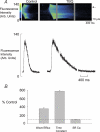Interplay between SERCA and sarcolemmal Ca2+ efflux pathways controls spontaneous release of Ca2+ from the sarcoplasmic reticulum in rat ventricular myocytes
- PMID: 15194743
- PMCID: PMC1665077
- DOI: 10.1113/jphysiol.2003.058917
Interplay between SERCA and sarcolemmal Ca2+ efflux pathways controls spontaneous release of Ca2+ from the sarcoplasmic reticulum in rat ventricular myocytes
Abstract
Waves of calcium-induced calcium release occur in a variety of cell types and have been implicated in the origin of cardiac arrhythmias. We have investigated the effects of inhibiting the SR Ca(2+)-ATPase (SERCA) with the reversible inhibitor 2',5'-di(tert-butyl)-1,4-benzohydroquinone (TBQ) on the properties of these waves. Cardiac myocytes were voltage clamped at a constant potential between -65 and -40 mV and spontaneous waves evoked by increasing external Ca(2+) concentration to 4 mm. Application of 100 microm TBQ decreased the frequency of waves. This was associated with increases of resting [Ca(2+)](i), the time constant of decay of [Ca(2+)](i) and the integral of the accompanying Na(+)-Ca(2+) exchange current. There was also a decrease in propagation velocity of the waves. There was an increase of the calculated Ca(2+) efflux per wave. The SR Ca(2+) content when a wave was about to propagate decreased to 91.7 +/- 3.2%. The period between waves increased in direct proportion to the Ca(2+) efflux per wave meaning that TBQ had no effect on the Ca(2+) efflux per unit time. We conclude that (i) decreased wave frequency is not a direct consequence of decreased Ca(2+) pumping by SERCA between waves but, rather, to more Ca(2+) loss on each wave; (ii) inhibiting SERCA increases the chance of spontaneous Ca(2+) release propagating at a given SR content.
Figures






References
-
- Berlin JR, Cannell MB, Lederer WJ. Cellular origins of the transient inward current in cardiac myocytes: role of fluctuations and waves of elevated intracellular calcium. Circ Res. 1989;65:115–126. - PubMed
-
- Berridge MJ, Lipp P, Bootman MD. The versatility and universality of calcium signalling. Nat Rev Mol Cell Biol. 2000;1:11–21. - PubMed
MeSH terms
Substances
LinkOut - more resources
Full Text Sources
Research Materials
Miscellaneous

